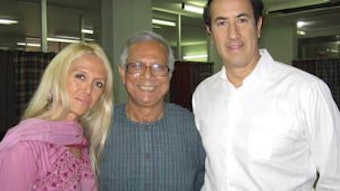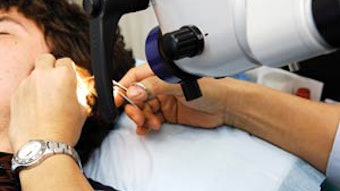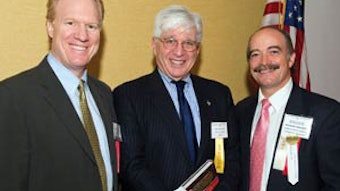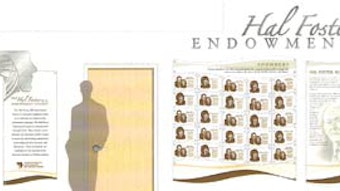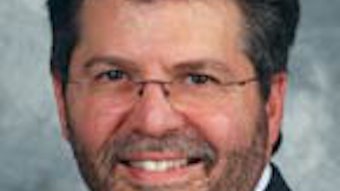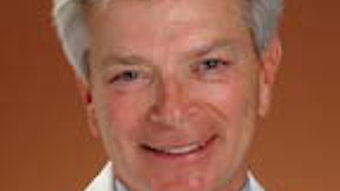The Childcare Dilemma: Daycare vs. Nanny Care
Pamela C. Roehm, MD, PhD Assistant Professor Department of Otolaryngology NYU School of Medicine Working parents face the dilemma: Who will take care of their children? For otolaryngologists, this issue is complicated by long hours and variable schedules. When otolaryngologists have children, they frequently have them during residency or early years of practice, when hours are long and dollars are few. In the new millennium, the concept of work before family no longer holds precedence for men or women, and more women work outside the home.1, 2 Thus otolaryngologists, male or female, must consider childcare issues. These become more pertinent to the ENT community as more women enter otolaryngology; in 2010, more than half of otolaryngology residency applicants were female.3 Even when women are primary breadwinners, they tend to be primary caregivers for children; this relationship holds true for female surgeons.4, 5 For these reasons, the Women in Otolaryngology Section has determined that childcare is a key issue for practicing otolaryngologists. One option is childcare provided by a family member, but this is not always possible. Often, the decision boils down to daycare vs. a nanny. Each choice has advantages and disadvantages, and there are avid advocates of each. I will address advantages and disadvantages of daycare, and then nanny care. Not all daycare is the same. Facilities range from large corporate-run entities with multiple classrooms and children separated by age, to smaller family-run daycare centers with only one provider within the home. Advantages and disadvantages of daycare differ significantly based on these factors. One advantage of all types of daycare is that your children will be raised in the presence of other unrelated children. Thus from an early age, your child will learn how to interact with peers. A second advantage is that daycare providers do not live in your house, so you don’t have to supply a vehicle for your daycare provider, as you might for a full-time nanny. Also, state-directed mandates require daycare workers to have additional educational degrees and training that nannies may not have. Daycare is frequently less expensive than a full-time nanny. If you have work-subsidized daycare, your savings may be greater. Daycare facilities will often provide discounts of 10 percent to 25 percent for siblings. Costs differ based on geographic location and the age of your child. Typically, full-time daycare costs $100 to $400 Monday through Friday, with an additional $25 to $100 per month for children under 2 years old. Costs include tuition during vacations when your children are not present at daycare and backup care during daycare holidays. Additional costs can include supplies and diaper, laundry, and activity fees. Most daycares provide snacks, and sometimes even lunch. Larger daycare facilities benefit from a larger workforce. As a consequence, centers do not close if one provider is absent, unlike family-run daycare (and nannies). There are multiple “eyes” on your child, minimizing the impact of interpersonal conflicts and negligent caregivers. Often larger facilities will have a planned curriculum of activities. Finally, larger centers are more likely to meet state-mandated standards. However, they can be less personal, and may shuffle daycare providers throughout the facility on a day-to-day basis. They also may not cater to dietary restrictions, unlike smaller daycare settings. In contrast, family-run daycare can have many of the advantages of a nanny, such as a more personal quality. Unfortunately, smaller centers also face some of the disadvantages of nanny care, including cancellations due to vacations or illness of the caregiver. Common disadvantages of daycare include multiple infections that your children will contract after contact with other children. This can lead to costs for backup care for your child and/or lost income when you or your children are ill. A second disadvantage is that your children may be sent home when they appear to facility personnel to be sick. A note from your child’s pediatrician may be required prior to return to daycare, necessitating lost work time. Long waiting lists for daycare enrollment are another potential downside. Daycare drop-off and pick-up times are firm and will not accommodate occasional emergency calls or late cases. Full-time daycare typically will not extend through a full surgical-length workday, and daycare is not open on weekends and holidays. Finally, unlike a nanny, daycare workers will not take your child to pediatric or dental appointments or to extracurricular activities. There are as many permutations to nanny care as to daycare. Nannies come with a variety of experience levels, from untrained babysitters to individuals with master’s degrees. Nannies can live in your home part-time, full-time, or not at all. Benefits and salary are negotiable in the contract, as are work hours and expectations regarding activities and schedules for your children. For a full-time otolaryngologist, the scheduling flexibility that a nanny can offer may be the only workable solution to covering a long workday or last-minute cases and delays. This type of flexibility must be discussed thoroughly in advance with the nanny applicant to avoid gaps in childcare coverage. Overtime pay must be discussed and agreed upon prior to entering the nanny contract. For residents, live-in nannies, who are typically the most flexible for providing last-minute childcare, may be the best choice. One exception is that au pairs can work only up to 45 hours per week, and so will not be able to provide adequate childcare coverage for a surgeon. Another advantage of nanny care is the convenience of having a childcare provider in your home, thus avoiding the time and difficulty involved in preparing and transporting your children to another site. Your children will be raised in a familiar environment. Light chores may be negotiated into the nanny contract. You can determine how your child is disciplined, when nap and meal times occur, and what food and activities are offered. With a nanny, your child can have one-on-one attention. A nanny will take care of your children even if they are sick, and your children may develop a strong bond with their nanny that lasts for years. Nanny care can be more expensive than daycare, especially if you have only one child and have negotiated an hourly rate, rather than a fixed salary. Rates run from $20,000 to $50,000 per year for full-time nannies or $10 to $19 by hour. Wages vary by education, experience, and geographic location. Salaries are lower for live-in nannies. For larger families, rates for nanny care may be less expensive than those for daycare. Taxes, including FICA, should be calculated into the costs of having a nanny. There are disadvantages to nanny care. The greatest is that there is no built-in backup for your nanny if she is unable to take care of your children. If she becomes sick, you have to find alternative care. Similarly, if she quits, you may be interviewing nannies over the phone late at night before a long day in the OR. Another disadvantage is that nanny care is extremely variable. Some nannies are wonderful, others are dreadful. Finding one whom you trust can be difficult, and many families use nanny-cams to ensure that proper care is being given. Unlike daycare, where baseline education levels and additional training (CPR) are governed by state mandates, nannies may be uneducated. Background searches on credentials and letters of recommendation are a must when hiring a nanny. Socialization may be lacking for children left in nannies’ care. Playdates and extracurricular activities need to be planned in advance to provide crucial peer interactions. You may need to supply a car, gas, and other benefits to the nanny. Since a nanny works in your home, privacy can be an issue, so limits must be set from the beginning. Regardless of the option chosen, backup care provisions must be available with very short notice to avoid compromising patient care. Backup care can range from drop-off daycare to backup nanny care through an emergency service. Either option tends to be expensive ($18 or more per hour). You must register for these services ahead of time. During times of high demand, you will need to contact backup care providers well in advance to secure their services. References Alsop R. “The ‘Trophy Kids’ Go To Work,” Wall Street Journal, October 21, 2008, D1. United States Department of Labor, “Employment Characteristics of Families Summary,” released 5/27/2010 (http://www.bls.gov/news.release/famee.nr0.htm). Association of American Medical Colleges, “FACTS: Applicants, Matriculants, Enrollment, Graduates, MD/PhD and Residency Applicants Data,” last accessed 12/29/2010 (https://www.aamc.org/data/facts/). Krueger AB, Mueller A. “Job Search and Unemployment Insurance: New Evidence from Time Use Data,” J Public Economics 2010;94:298-307. Troppmann KM et al, “Women Surgeons in the New Millennium,” Arch Surg 2009;144:635-642.

Assistant Professor
Department of Otolaryngology
NYU School of Medicine
Working parents face the dilemma: Who will take care of their children? For otolaryngologists, this issue is complicated by long hours and variable schedules. When otolaryngologists have children, they frequently have them during residency or early years of practice, when hours are long and dollars are few. In the new millennium, the concept of work before family no longer holds precedence for men or women, and more women work outside the home.1, 2 Thus otolaryngologists, male or female, must consider childcare issues. These become more pertinent to the ENT community as more women enter otolaryngology; in 2010, more than half of otolaryngology residency applicants were female.3 Even when women are primary breadwinners, they tend to be primary caregivers for children; this relationship holds true for female surgeons.4, 5 For these reasons, the Women in Otolaryngology Section has determined that childcare is a key issue for practicing otolaryngologists.
One option is childcare provided by a family member, but this is not always possible. Often, the decision boils down to daycare vs. a nanny. Each choice has advantages and disadvantages, and there are avid advocates of each. I will address advantages and disadvantages of daycare, and then nanny care.
Not all daycare is the same. Facilities range from large corporate-run entities with multiple classrooms and children separated by age, to smaller family-run daycare centers with only one provider within the home. Advantages and disadvantages of daycare differ significantly based on these factors.
One advantage of all types of daycare is that your children will be raised in the presence of other unrelated children. Thus from an early age, your child will learn how to interact with peers. A second advantage is that daycare providers do not live in your house, so you don’t have to supply a vehicle for your daycare provider, as you might for a full-time nanny. Also, state-directed mandates require daycare workers to have additional educational degrees and training that nannies may not have.
Daycare is frequently less expensive than a full-time nanny. If you have work-subsidized daycare, your savings may be greater. Daycare facilities will often provide discounts of 10 percent to 25 percent for siblings. Costs differ based on geographic location and the age of your child. Typically, full-time daycare costs $100 to $400 Monday through Friday, with an additional $25 to $100 per month for children under 2 years old. Costs include tuition during vacations when your children are not present at daycare and backup care during daycare holidays. Additional costs can include supplies and diaper, laundry, and activity fees. Most daycares provide snacks, and sometimes even lunch.
Larger daycare facilities benefit from a larger workforce. As a consequence, centers do not close if one provider is absent, unlike family-run daycare (and nannies). There are multiple “eyes” on your child, minimizing the impact of interpersonal conflicts and negligent caregivers. Often larger facilities will have a planned curriculum of activities. Finally, larger centers are more likely to meet state-mandated standards. However, they can be less personal, and may shuffle daycare providers throughout the facility on a day-to-day basis. They also may not cater to dietary restrictions, unlike smaller daycare settings.
In contrast, family-run daycare can have many of the advantages of a nanny, such as a more personal quality. Unfortunately, smaller centers also face some of the disadvantages of nanny care, including cancellations due to vacations or illness of the caregiver.
Common disadvantages of daycare include multiple infections that your children will contract after contact with other children. This can lead to costs for backup care for your child and/or lost income when you or your children are ill. A second disadvantage is that your children may be sent home when they appear to facility personnel to be sick. A note from your child’s pediatrician may be required prior to return to daycare, necessitating lost work time. Long waiting lists for daycare enrollment are another potential downside.
Daycare drop-off and pick-up times are firm and will not accommodate occasional emergency calls or late cases. Full-time daycare typically will not extend through a full surgical-length workday, and daycare is not open on weekends and holidays. Finally, unlike a nanny, daycare workers will not take your child to pediatric or dental appointments or to extracurricular activities.
There are as many permutations to nanny care as to daycare. Nannies come with a variety of experience levels, from untrained babysitters to individuals with master’s degrees. Nannies can live in your home part-time, full-time, or not at all. Benefits and salary are negotiable in the contract, as are work hours and expectations regarding activities and schedules for your children.
For a full-time otolaryngologist, the scheduling flexibility that a nanny can offer may be the only workable solution to covering a long workday or last-minute cases and delays. This type of flexibility must be discussed thoroughly in advance with the nanny applicant to avoid gaps in childcare coverage. Overtime pay must be discussed and agreed upon prior to entering the nanny contract. For residents, live-in nannies, who are typically the most flexible for providing last-minute childcare, may be the best choice. One exception is that au pairs can work only up to 45 hours per week, and so will not be able to provide adequate childcare coverage for a surgeon.
Another advantage of nanny care is the convenience of having a childcare provider in your home, thus avoiding the time and difficulty involved in preparing and transporting your children to another site. Your children will be raised in a familiar environment. Light chores may be negotiated into the nanny contract. You can determine how your child is disciplined, when nap and meal times occur, and what food and activities are offered. With a nanny, your child can have one-on-one attention. A nanny will take care of your children even if they are sick, and your children may develop a strong bond with their nanny that lasts for years.
Nanny care can be more expensive than daycare, especially if you have only one child and have negotiated an hourly rate, rather than a fixed salary. Rates run from $20,000 to $50,000 per year for full-time nannies or $10 to $19 by hour. Wages vary by education, experience, and geographic location. Salaries are lower for live-in nannies. For larger families, rates for nanny care may be less expensive than those for daycare. Taxes, including FICA, should be calculated into the costs of having a nanny.
There are disadvantages to nanny care. The greatest is that there is no built-in backup for your nanny if she is unable to take care of your children. If she becomes sick, you have to find alternative care. Similarly, if she quits, you may be interviewing nannies over the phone late at night before a long day in the OR. Another disadvantage is that nanny care is extremely variable. Some nannies are wonderful, others are dreadful. Finding one whom you trust can be difficult, and many families use nanny-cams to ensure that proper care is being given. Unlike daycare, where baseline education levels and additional training (CPR) are governed by state mandates, nannies may be uneducated. Background searches on credentials and letters of recommendation are a must when hiring a nanny. Socialization may be lacking for children left in nannies’ care. Playdates and extracurricular activities need to be planned in advance to provide crucial peer interactions. You may need to supply a car, gas, and other benefits to the nanny. Since a nanny works in your home, privacy can be an issue, so limits must be set from the beginning.
Regardless of the option chosen, backup care provisions must be available with very short notice to avoid compromising patient care. Backup care can range from drop-off daycare to backup nanny care through an emergency service. Either option tends to be expensive ($18 or more per hour). You must register for these services ahead of time. During times of high demand, you will need to contact backup care providers well in advance to secure their services.
References
- Alsop R. “The ‘Trophy Kids’ Go To Work,” Wall Street Journal, October 21, 2008, D1.
- United States Department of Labor, “Employment Characteristics of Families Summary,” released 5/27/2010 (http://www.bls.gov/news.release/famee.nr0.htm).
- Association of American Medical Colleges, “FACTS: Applicants, Matriculants, Enrollment, Graduates, MD/PhD and Residency Applicants Data,” last accessed 12/29/2010 (https://www.aamc.org/data/facts/).
- Krueger AB, Mueller A. “Job Search and Unemployment Insurance: New Evidence from Time Use Data,” J Public Economics 2010;94:298-307. Troppmann KM et al, “Women Surgeons in the New Millennium,” Arch Surg 2009;144:635-642.
